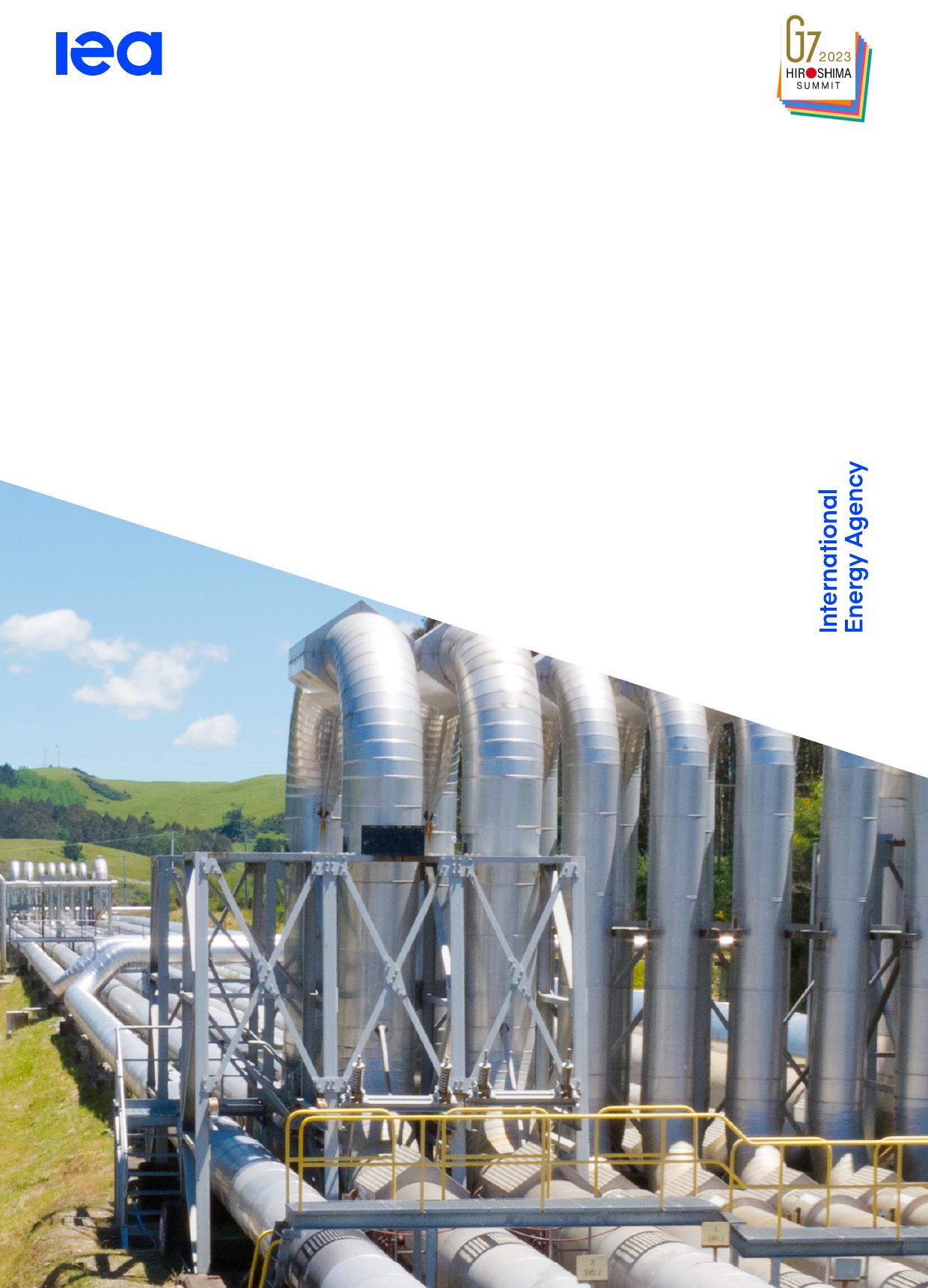OutlooksforgasmarketsandinvestmentTheIEAexaminesthefullspectrumofenergyissuesincludingoil,gasandcoalsupplyanddemand,renewableenergytechnologies,electricitymarkets,energyefficiency,accesstoenergy,demandsidemanagementandmuchmore.Throughitswork,theIEAadvocatespoliciesthatwillenhancethereliability,affordabilityandsustainabilityofenergyinits31membercountries,11associationcountriesandbeyond.Thispublicationandanymapincludedhereinarewithoutprejudicetothestatusoforsovereigntyoveranyterritory,tothedelimitationofinternationalfrontiersandboundariesandtothenameofanyterritory,cityorarea.Source:IEA.InternationalEnergyAgencyWebsite:www.iea.orgIEAmembercountries:AustraliaAustriaBelgiumCanadaCzechRepublicDenmarkEstoniaFinlandFranceGermanyGreeceHungaryIrelandItalyJapanKoreaLithuaniaLuxembourgMexicoNetherlandsNewZealandNorwayPolandPortugalSlovakRepublicSpainSwedenSwitzerlandRepublicofTürkiyeUnitedKingdomUnitedStatesTheEuropeanCommissionalsoparticipatesintheworkoftheIEAIEAassociationcountries:ArgentinaBrazilChinaEgyptIndiaIndonesiaMoroccoSingaporeSouthAfricaThailandUkraineINTERNATIONALENERGYAGENCYOutlooksforgasmarketsandinvestment:areportfortheG7PAGE3IEA.CCBY4.0.AbstractInthemidstofaglobalenergycrisis,fundamentalquestionsarenowbeingaskedaboutnaturalgas:howcansupplybeassured,nowandinthefuture,andatwhatprice?ThispaperexplorestheuncertaintyaroundnaturalgasusinginsightsfromthescenariosunderpinningtheWorldEnergyOutlook2022,aswellasaselectionofotherglobalscenario-basedassessments.Outlooksforgasmarketsandinvestment:areportfortheG7PAGE4IEA.CCBY4.0.IntroductionInthemidstofaglobalenergycrisisinwhichshortagesofnaturalgashaveplayedacentralrole,fundamentalquestionsarenowbeingaskedaboutthelong-termfutureofnaturalgas.Thecrisishasremindedpolicymakersandenergyconsumersoftheimmediateimportanceofstableandaffordablenaturalgassupplies.Thetraditionalargumentsinfavourofgas–itsroleasareliablepartnertothecleanenergytransitionanditsabilitytostepintofillthegapleftbydecliningcoalandoil–arealsobeingtested.Gasisaversatilefuelusedwidelyacrosstheenergyeconomy,butthismeansthatinthecurrentcontexthigherpricesandtightsuppliesareaffectingawiderangeofenergyservicesandindustrialsupplychains,suchasfood,textilesandrawmaterials.NaturalgaspricesinimportingcountriesinEuropeandAsiaarelikelytoremainincreasinglyvolatileandinrelativelyhighrangesoverthenextfewyears,asEurope’sdrivetoreducerelianceonRussianimportskeepsglobalgasmarketstightduringarelativelybarrenperiodforlargenewgasexportprojects.Arebalancingisexpectedfromthemid-2020s,whenaslateofnewLNGsupplyprojectscomeonline.Butthe“goldenageofgas”thattheIEApositedin2011isnowappearingintherear-viewmirror:gasremainsamajorpartoftheglobalenergymix,buttoday’scrisishasundercutmomentumbehindnaturalgasexpansioninsomelargepotentialmarketsinSouthandSoutheastAsia.Whethertoday’scrisisleavesanenduringdentintheideaofnaturalgasasatransitionfuelisacrucialuncertaintyforglobalenergy.Thenear-termeffectsoftoday’stightgasmarketsareacceleratingpre-existingtrendsinEuropethathavebeendampeningmomentumfornaturalgasinrecentyears.Renewablesareincreasinglycost-competitiveinthepowersector,thereisgreaterpolicysupportforelectrificationofheatdemandinbothbuildingsandindustry,especiallyinadvancedeconomies,whilegrowthinmanufacturingcapabilitiesforbatteriesandhydrogenelectrolysersaresettochallengetheroleofgasasaproviderofshort-andlong-termflexibility.However,itisnotaxiomaticthatbadnewsforgasisgoodnewsforenergytransitions:loominglargeinthebackdropistheriskthatrecedingenthusiasmfornaturalgas,inpractice,leadstoarevivalincoaldemand,asdevelopingmarketslooktomorecompetitiveandreliabledomesticcoalsupplies.Strongclimatepoliciesandinternationalsupportforfinancingcleanerenergyareessentialtomitigatethisrisk.InthispaperweexploretheroleofnaturalgasusinginsightsfromthescenariosunderpinningtheWorldEnergyOutlook2022:TheStatedPoliciesScenario(STEPS)showsthetrajectoryimpliedbytoday’spolicysettings.TheAnnouncedPledgesScenario(APS)assumesthatallaspirationaltargetsannouncedbygovernmentsaremetontimeandinfull,includingtheirlong‐termnetzeroandenergyaccessgoals.TheNetZeroEmissionsby2050Scenario(NZE)mapsoutawaytoachievea1.5°Cstabilisationintheriseinglobalaveragetemperatures,alongsideuniversalaccesstomodernenergyby2030.WealsobenchmarkIEAscenariosagainstthosefromotherinstitutions,notablyfromtheInstituteofEnergyEconomicsofJapan(IEEJ),withwhomwehavecooperatedonthispaper.Outlooksforgasmarketsandinvestment:areportfortheG7PAGE5IEA.CCBY4.0.GlobalgastrendsThestartingpointofthisstudyistocomparethetrajectoryfornaturalgasdemandacrossseveralrecentscenario-basedassessments.Suchassessmentsinvolvedifferentassumptionsregardingmacroeconomicconditions,underlyingenergyservicedemandaswellastechnologies,costs,policyevolutionandcommoditypricesacrossdifferentgeographies,timeframesandscenarios.Thisnaturallyleadstodifferentscenariooutcomes.Scenariodesignisakeyparameter:exploratoryscenariosfixsomekeystartingconditionsandexaminewhattheyimplyforthefuture.Normativescenariosfixtheendpointandworkouthowtogetthere.Comparinggrowthprojectionsacrossasampleofglobalassessments,theconsensusviewisthatnaturalgasfaresmoderatelywellinthecomingdecade,buttherearelargedivergencesbeyondthat.Fromastartinglevelof4200bcmin2021,twoscenariosanticipatenaturalgastoriseabove5000bcmby2050,fourscenariosseedemandinarangebetween4000–5000bcm,anotherfourfallinarangebetween2500–4000bcm,whiletheremainingfourscenariosseedemandbelow2500bcmby2050.NaturalgasdemandintheWorldEnergyOutlook2022comparedtootherscenario-basedassessmentsIEA.CCBY4.0.Note:valuesforexternalprojectionsaregrowthratesnormalisedtoanIEAhistoricalbaseline.Extrapolationsweremadeincaseswherespecificyearswereunavailable.Externalscenariosaregroupedaccordingto‘reference’or‘acceleratedtechnology’cases(smalldottedlines)andclimate-focussedscenarios(largedottedlines).Sources:IEA(2022),WorldEnergyOutlook2022.BP(2023);Equinor(2022);IEEJ(2022);OPEC(2022);Shell(2023)Theprimaryfactorexplainingthedifferenceisthelevelofclimateambition.Butwithinthisthereareanumberofkeyassumptionsaboutsectoralandtechnologicaltrends.Inthenear-termto2030,scenariosdifferregardingthepaceandscaleofrenewablesdeploymentinthepowersectorandtheextenttowhichcoal-to-gas100020003000400050006000200020102019203020402050BcmSTEPSAPSNZEIEEJReferenceBP-NewMomentumOPECReferenceIEEJ-ATSEquinor-WallsShell-ArchipelagosBP-AcceleratedShell-SkyBP-NetZeroEquinor-BridgesOutlooksforgasmarketsandinvestment:areportfortheG7PAGE6IEA.CCBY4.0.switchingisutilisedfortheenergytransition.Overthelong-term,scenariosdifferregardingtherateofindustrialheatdecarbonisation,theroleofnaturalgasasaninputtohydrogenproduction,andtheextenttowhichnaturalgaswillplayanenduringroleinprovidingflexibilitytopowersystems.Broaderenergysystemtransformationsareequallylikelytoaffecttheoutlookforgas,suchastheextenttowhichcarboncapture,utilisationandstorage(CCUS)andnegativeemissionstechnologiesplayalargerole.Assumptionsaboutgaspricesandtheoverallcost-competitivenessofalternativetechnologiescanalsochangethelevelofnaturalgasdemandinsubsequentdecades.BelowwetakeacloserlookatthesedriversusingtheIEAscenariospresentedintheWorldEnergyOutlook2022.NaturalgasdemandIntheStatedPoliciesScenario(STEPS),globalnaturalgasdemandrisesatanaveragerateof0.4%peryearbetween2021and2030,wellbelowthe2.2%averagerateofgrowthseenbetween2010and2021.Demandreaches4400bcmin2030andstaysatthatlevelto2050.IntheAnnouncedPledgesScenario(APS),globalnaturalgasdemandsoonpeaks,andby2030isnearly10%lowerthanitwasin2021.By2050,demandis40%below2021levels.IntheNetZeroEmissionsby2050(NZE)Scenario,naturalgasdemandfallsfurtherandfasterthanintheSTEPSandAPS,decliningto3300bcmin2030and1200bcmin2050.Industryisthemostresilientsectorfornaturalgasdemandacrossallscenarios.IntheSTEPS,growthinnaturalgasdemandinsubsectorssuchasmanufacturing,fertilisersandpetrochemicalsaccountsfor90%ofoverallnaturalgasdemandgrowthbetween2021and2030.However,manyindustrialsectorsaresensitivetochangesingasprices;weestimatethatindustrialgasdemandin2022fellby30bcmor3.3%comparedto2021,withEuropebearingthebruntoftheadjustmentasfertiliserproducersinparticularcurtailedtheirproduction.IntheAPS,naturalgasdemandinindustrygloballyfallsby2%between2021and2030andby7%intheNZEScenario.IntheSTEPS,arapidaccelerationinefficiencyimprovementsandbroad‐basedadoptionofheatpumpsreducesuseinbuildingsby65bcminadvancedeconomiesbetween2021and2030.IntheAPS,therateofdeclinetriples,withgasuseinbuildingsfallingby170bcmbetween2021and2030,or30%ofdemandin2021.Thesereductionshoweverarepartlyoffsetbyincreasesinemergingmarketanddevelopingeconomies.Between2030and2050,naturalgasuseinbuildingsfallsafurther4%intheSTEPS,50%intheAPS,andfallstozerointheNZEScenario.Outlooksforgasmarketsandinvestment:areportfortheG7PAGE7IEA.CCBY4.0.Inthepowersector,naturalgasdemanddeclinesbyabout3%intheSTEPSbetween2021and2030,withgainsinemergingmarketanddevelopingeconomiesmorethanoffsetbydeclinesinadvancedeconomies.IntheAPS,fastergrowthinrenewablesmeansthatmorenaturalgas‐firedpowerplantsmovefrombaseloadtoflexibleprovidersofelectricitygeneration,meaninglessgasisconsumedinthepowersectorevenasadditionalcapacityisaddedforflexibilitypurposes;thereislimitedcoal‐to‐gasswitchingasdemandshiftsdirectlytorenewablesorotherlow‐emissionsoptions.ThiseffectismorepronouncedintheNZEScenario,wherepowersectorgasdemandfallsby450bcm,or25%of2021levels,by2030.Naturalgasdemandbysectorandscenario,2020-2050IEA.CCBY4.0.Note.Otherincludesagricultureandothernon-energyuse.Acrossallthreescenarios,naturalgasisanticipatedtodeclineinadvancedeconomies.Thisisinlargepartthankstogrowingpolicysupportandincentivesforcleanenergyandefficiency,bothofwhicherodenaturalgas’marketshareinallsectors.IntheUnitedStates,theInflationReductionActgivessignificanttaxincentivesandotherformsofsupporttorenewables,nuclearandbiogases–alongsideefficiencyandheatpumps.InJapan,thelong-termfocusonlow-emissionsfuelssuchasammoniaandhydrogen,alongsidethemid-termplannedrestartofnuclear,translatesintoarelativelyrapidreductioninLNGdemand,toasmuchas40%below2021levelsby2030,withthepaceofreductiondependentonthepaceofdeploymentandimplementationofnewenergyandnuclearenergyinitiatives.IntheEuropeanUnion,thefullimplementationofFitfor55andadditionalambitionsintheRePowerEUcommunicationmeansnaturalgasdemandfalls20%below2021levels.1000200030004000500020202050BcmBuildingsIndustryPowerOtherenergysectorTransportOtherSTEPSAPSNZE2020205020202050Outlooksforgasmarketsandinvestment:areportfortheG7PAGE8IEA.CCBY4.0.ChangeinnaturalgasdemandbyregionandscenarioIEA.CCBY4.0.Inemergingmarketanddevelopingeconomies,naturalgasdemandintheSTEPSrisesby110bcmbetween2021and2030,ataroundone-fifthofthegrowthrateseeninthepreviousdecade.China’sannualdemandgrowthinparticulardeceleratessharply,fromanaverageof12%peryearbetween2010and2021to2%peryearbetween2021and2030.Thereislessscopeforcoal‐to‐gasswitchingandincreaseduseofelectricityinindustrycomparedtotheSTEPSintheWorldEnergyOutlook2021.AffordabilityconcernsinsomepartsofAsia,particularlyPakistanandBangladesh,alongsidematuringdomesticproductionandpersistenthurdlestobuildingimportinfrastructureinSoutheastAsia,alldampenmomentumbehindgas.Naturalgassupply,tradeandinvestmentInvestmentinupstreamnaturalgassupplyintheSTEPSandAPS,2015-2030IEA.CCBY4.0.-1400-1000-600-20020060010002010-20212021-20302030-20502021-20302030-2050BcmRestofworldAfricaMiddleEastDevelopingAsiaJapanandKoreaNorthAmericaEuropeNetchangeStatedPoliciesAnnouncedPledges250030003500400045002015202020252030AssociatedgasAlreadyapprovedUnconventionalsNewapprovalsBcmIncreasedproductionStatedPoliciesProjects2015202020252030DemandDeclinesfromexistingAnnouncedPledgesOutlooksforgasmarketsandinvestment:areportfortheG7PAGE9IEA.CCBY4.0.DespiteflatordecliningnaturalgasdemandintheSTEPSandAPS,additionalupstreaminvestmentisnonethelessrequiredtooffsetdeclinesfromexistingfields.Recentlyapprovedprojectsaddaround400bcmperyeartoglobalgassupplybytheendofthe2020s.Thisleavesaround720bcmofnewupstreamsupplyneededtomeetgasdemandintheSTEPSby2030.Thisnewsupplyrequirementfallstojustunder500bcmintheAPS.IntheNZEScenario,thereductionsinnaturalgasdemandaresufficientlysteepthatitispossibletomeetthem,inaggregate,bycontinuedinvestmentinexistingassetsandalreadyapprovedprojects,butwithoutanynewlongleadtimeupstreamconventionalprojects.ThetotalinvestmentrequirementinnaturalgassupplyandtransportfortheremainingdecadeisUSD280billionperyear,onaverage,intheSTEPSandUSD240billionintheAPS.IntheNZEScenario,aroundUSD200billionisrequiredtomaintainoutputatexistingandcommissionalreadyapprovedfields.Inallscenarios,thereisaneedtoreducetheemissionsintensityofgassupplybyreducingflaringandmethaneleaks.Morethan260bcmofnaturalgasiswastedeachyearinthisway.Itisunlikelythatallofthiscanbeavoided,butaccordingtotheIEA’sMethaneTrackeranestimated200bcmofadditionalgascouldbebroughttomarketswiththerightpoliciesandon-the-groundimplementation.Stoppingthiswasteofnaturalgaswouldalsoreduceglobaltemperaturerisebynearly0.1°Cbymid-century,withaneffectequaltoeliminatingtheGHGemissionsfromalloftheworld’scars,trucks,busesandtwo-andthree-wheelervehicles.AccordingtotheIEA’sMethaneTracker,aroundUSD100billionininvestmentisrequiredto2030todeployallmethaneabatementmeasuresintheoilandgassector,andthemajoritycanbedeployedatnonetcostgiventhecapturedgascanbemarketedandsold.LNGtradebyscenariocomparedtoexistingandunder-constructioncapacity,2015-2050IEA.CCBY4.0.Note.LNGcapacityisadjustedtoreflectinter‐regionaltradebetweenregionsmodelledintheGlobalEnergyandClimateModel,andde‐ratedto80%ofnameplatecapacity.20040060080020152020202520302035204020452050bcmStatedPoliciesAnnouncedPledgesNetZeroby2050ExistingLNGcapacityUnderconstructionTradeOutlooksforgasmarketsandinvestment:areportfortheG7PAGE10IEA.CCBY4.0.AroundhalfofallupstreamgasprojectsapprovedinthelastfiveyearshavebeenexplicitlytiedtoLNGexportprojects.IntheSTEPSanadditional240bcmperyearofLNGexportcapacityisneededby2050abovewhatcurrentlyexistsorisunderconstruction(evenastherateofgrowthinLNGtradebetween2021and2030fallstoone-fifthofthelevelsofthelastfiveyears).IntheAPS,onlyprojectscurrentlyunderconstructionarerequired.IntheNZEScenario,asharpdecreaseinnaturalgasdemandgloballymeansthateventheseprojectsareinmanycasesnolongernecessary.ThiswidespectrumofLNGrequirementscreatesadilemmaforsponsorsofnewLNGprojects,wheretheriskofunrecoveredcapitalincreaseswithgreaterclimateambition.Themainexposureisvialowerequilibriumgasprices.Insomecases,thisriskismitigatedbylong-termcontractsofferingstablepricingconditions;however,forimportersthereisariskofexposuretorelativelyhighgaspricesfordecades,inabroadercontextofdemanduncertainty.IntheAPS,thelong-runaveragegaspriceinEuropeisaroundUSD7/MBtuandaroundUSD8/MBtuinimportingcountriesinAsia,around20%lowerthanintheSTEPS.Thiswouldbringthesumofthenetpresentvalueofrecently-sanctionedLNGexportprojectswithcapitalyettorecoverclosetozero,fromaroundUSD320billionintheSTEPS.IntheNZEScenario,thepriceaveragesUSD4.5/MBtuinEuropeandUSD5.5/MBtuinAsia.AlongwithsharplylowerLNGdemandcomparedtotheSTEPS,theNZEScenarioimpliesevenmorechallengingeconomicsforprojectscurrentlyunderconstruction.AsLNGexportersjostlefordiminishingmarketshare,theutilisationratesofindividualplantsbecomeuncertain;thereisacasethatonlythelowestcostproducersareleftstanding,butsecurityofsupplyconcernsmayencouragegovernmentstosupporthigher-costprojects.Sensitivityanalysisonthenetpresentvalueofrecently-sanctionedLNGprojectsIEA.CCBY4.0.-400-2000200400Taxrate(30%)Discountrate(6%)Lifetime(30years)Utilisation(85%)Price(USD9.5/MBtu)USDBillion(2021)-10%-20%+10%+20%Indicator(baselinevalue)Outlooksforgasmarketsandinvestment:areportfortheG7PAGE11IEA.CCBY4.0.ThedifferenttrajectoriesforgasdemandinWEOscenarioshighlightsakeydilemmaforinvestorsconsideringlarge,capital‐intensiveLNGprojects:howtoreconcilestrongnear‐termdemandgrowthwithuncertainbutpossiblydeclininglongertermdemand.OnewayofresolvingthisdifficultywouldbetoshortenthecontracttenurefornewLNGprojects,howeverthiswouldincreasethebreak-evenpriceneededtofullyrecoupinvestmentcostsbymorethan25%.Anotherwaytoincreasethecompatibilityofsuchinvestmentswithenergytransitionswouldbetointegratelow-emissionstechnologiesintothevaluechains,forexamplethroughCCUSonthefinalusesorthroughtheuseofinfrastructureforlow-emissionsgases.FocusonkeygrowthmarketsfornaturalgasinAsiaEmergingmarketanddevelopingcountriesinAsiahavebeenoneofthemainenginesofnaturalgasdemandgrowthoverthelastdecade.However,thestrainsonglobalnaturalgassupplythathaveemergedsince2021havechallengedthecasefornaturalgasasatransitionfuelinAsia.ThesurgeinLNGspotpricesarisingfromhighdemandinEuropehaspulledsupplyawayfromprice-sensitivemarketssuchasPakistanandBangladesh,leadingtoshortfallsinthepowersectorandindustrialdemanddestructioninthosecountries.Althoughsomemarketshavebeensomewhatshieldedfromvolatilitythankstolong-termsupplycontractswithfixedvolumecommitmentsandpricesthatarelinkedtooil,theimportpriceofgasforend-usersinemergingmarketsinAsiaisestimatedtohaverisenbyabout55%in2022comparedwiththefive-yearaverage.NetzeroemissionspledgesannouncedinsomeofthemajorgrowthmarketsinAsia–China,India,Malaysia,Singapore,ThailandandVietNam–alsohaveimplicationsforthefutureroleofnaturalgas.Thenear-termneedforsecuringgassuppliesiscomplicatedbytherelativelyshorttimeframeduringwhichnaturalgasdemandisexpectedtogrowinthesemarkets.Thestandardoperationallifetimeofnewgasinfrastructureisoften30yearsorlonger,raisingquestionsabouthowitistobefinancedandoperatedinscenariospursuinga1.5°Cstabilisation.Conversely,thereisariskthatdecliningprospectsforgasmaymeanthatemergingmarketanddevelopingeconomiesinAsiaholdontotheircoal-firedpowergenerationforlonger,which–unlessthereisahistoricaccelerationininvestmentinCCUS–wouldresultinunfavourableemissionsoutcomes.Thishashappenedbefore.Inenergy-hungryIndiaandSoutheastAsia,forexample,achallengingenvironmentfordomesticgasproductionbetween2010and2021meantnaturalgasbecamelesscompetitivewithcoal.TheresultwasaroundOutlooksforgasmarketsandinvestment:areportfortheG7PAGE12IEA.CCBY4.0.30bcmofnaturalgasdemandlosttogas-to-coalswitching,leadingtoa50MtCO2increaseinemissionswhichwouldhavebeenavoidedifnaturalgashadbeenusedinstead.DemandInboththeSTEPSandAPS,therearestrongmacroeconomicdriversforgrowthinnaturalgasconsumptioninemergingmarketanddevelopingeconomiesinAsiaoverthenextdecade,despitethenear-termrisksbroughtaboutbytherecentsupplysqueeze.Aspricesareprojectedtocomedownfromthemid-2020s,thesemarketsseeabigincreaseinnaturalgasuseby2030.Someofthisisdrivenbycoal-to-gasswitching(accountingforaround10%ofdemandgrowthinSTEPSand20%inAPS).Thishelpscountrieswithnetzeroemissionstargetsacceleratethetransitionawayfromcoal,evenifrenewablesarethemajorsourceofemissionsreductionsinbothscenarios.Industryremainstheanchorfordemandgrowthandthefocalpointforlarge-scaleinfrastructureinvestmentinLNGimportcapacity,storageandonshoretransmissionanddistributiongrids.IntheAPS,gasdemandinindustryinemerginggasmarketsinAsia,excludingChina,isover60%higherin2050thanin2021.NaturalgasdemandbysectorandscenarioinselectedregionsStatedPoliciesAnnouncedPledges201020212030205020302050ChinaBuildings3082103929732Industryandenergysectorownuse45170205219188112Powersectorinputs257490968284Other104245353910IndiaBuildings1491478Industryandenergysectorownuse292851935257Powersectorinputs291727292513Other41729332724SoutheastAsiaBuildings002312Industryandenergysectorownuse626471966687Powersectorinputs828311115110867Other61519211920Outlooksforgasmarketsandinvestment:areportfortheG7PAGE13IEA.CCBY4.0.StatedPoliciesAnnouncedPledges201020212030205020302050OtherdevelopingAsiaBuildings121620271726Industryandenergysectorownuse202831372926Powersectorinputs345053735743Other868877Note:Otherincludesuseintransport,agricultureandothernon-energyuse.After2030,naturalgasdemandgrowthinemergingmarketanddevelopingeconomiesinAsiaslowsinboththeSTEPSandtheAPS.Renewablesmeetthebulkgrowthinpowergenerationbetween2030and2050,whileelectricityandthedirectuseofrenewablesdominatebuildingssectorenergydemand.WiththeexceptionofnorthernChina,growthmarketsforgasinAsiadonothavesignificantneedforseasonalheatinginbuildings,andelectricityandsolar-basedheatingoffersacost-competitivealternativetotheuseofgasinhouseholdsforcookingandhotwater.Inindustry,naturalgasincreasesitsmarketshareoftotalindustrialdemandintheSTEPS,largelybydisplacingcoalandbioenergy.IntheAPS,theuseofhydrogenandelectricityinfinalconsumptioninindustryholdstheshareofnaturalgasflatataround9%throughto2050.LNGimportsandinfrastructureDevelopingmarketsinAsiaarethemainrecipientsofglobalLNGsuppliesto2050,despitethenear-termboosttoEuropeandemandbroughtaboutbydwindlingRussiangaspipelineexports.IntheSTEPS,ChinadominatesthegrowthinLNGdemand,whileSoutheastAsiaquicklybecomesanetimporterofLNGastraditionalproducingregionssuchasIndonesiaandMalaysiareachmaturityandaspiringimporterssuchasthePhilippinesandVietNamenterthemarket.Outlooksforgasmarketsandinvestment:areportfortheG7PAGE14IEA.CCBY4.0.NaturalgassupplybalanceinselectedcountriesandregionsbyscenarioIEA.CCBY4.0.Thereisaround200bcmperyearofexistingLNGimportcapacityintheregion(ofwhich45%isinChina).Afurther120bcmperyearisunderconstruction.TomeettherequirementsoftheSTEPSandAPS,afurther85bcmperyearofimportcapacityisrequiredby2030.Overthenextdecade,asLNGtradegrows,buyersinemerginganddevelopingeconomiesinAsiawillneedtocontractfornewvolumes.Inpractice,muchofthiswillberenewaloflegacycontractsasandwhentheyexpire;by2035,thereisaneedforaround150bcmperyearofnewcontractedsupplyintheSTEPSby2035.AsimilarlevelisrequiredintheAPS,whereLNGdemandinemergingAsianmarketscontinuestogrowstronglywellintothe2030s.-100010020030040050020102050201020502010205020102050ProductionfordomesticuseRemainingsupplybalance(nettrade)ChinaIndiaOtherAsiaSoutheastAsiaAnnouncedPledgesScenarioStatedPoliciesScenario-1000100200300400500bcmOutlooksforgasmarketsandinvestment:areportfortheG7PAGE15IEA.CCBY4.0.LNGimportcontractsinemergingmarketsanddevelopingeconomiesinAsiabyoriginofsuppliercomparedtonetLNGimportsbyscenarioIEA.CCBY4.0.Focus:ComparingIEAandIEEJScenariosTheIEEJ'sReferenceScenario(REF)isascenarioinwhichpasttrendchangescontinueunderexistingenergyandenvironmentalpolicies,whiletheAdvancedTechnologiesScenario(ATS)isascenarioinwhichtheintroductionoflow-carbontechnologiesprogressessignificantlythroughthestrengtheningofenergyandenvironmentalpolicies.Bothareexploratoryscenariosanddonotincorporatetheachievementofeachcountry'scarbon-neutralitydeclaration.TheATSassumesareasonableamountofintroductionofzero-emissiontechnologyinconsiderationofcost,potential,introductionspeed,andeconomicandsocialacceptance,anddoesnotassumeearlyachievementofcarbon-neutrality.Developingcountries,wherethedemandforenergyisincreasingrapidly,continuetoneedfossilfuelstomeetdemandintheATS,andamongthese,IEEJassessesthatnaturalgas,whichhasalowercarboncontent,playsalargerole.50100150200250300350201020152021202520302035BcmPortfolioAfricaEurasiaNorthAmericaMiddleEastAsiaPacificSTEPSAPSNZEHistoricalOutlooksforgasmarketsandinvestment:areportfortheG7PAGE16IEA.CCBY4.0.SelectedglobalenergyandeconomicindicatorsinIEAandIEEJscenariosIEA-STEPSIEA-APSIEEJ-REFIEEJ-ATS202020302050203020502030205020302050Totalprimaryenergydemand(EJ)592673740636629679749649610Totalelectricityconsumption(1000TWh)233042304729403042Shareofrenewablesinelectricitygeneration28%43%65%49%80%31%37%39%62%CO2combustionemissions(GtCO2)323329291136373117GDP(USDTrillion2021)91124197124197125207125207Worldoildemand(Mb/d)8910210293571061119662Worldcoaldemand(Mt)534751493828453916135635527249202723Worldnaturalgasdemand(Bcm)402743724357387426614641585544264588Bysector:Power15811590146914228801904281618021990Industry741869938763548828927799472Buildings839890852737372828748758327Other867102310979528601082136510681799Byregion:NorthAmerica109611188209333961228127812501051UnitedStates867864575716252948955877680Asia80099211189306511080160210251083China324443442406238414515396311India61115170110102113263116173Japan1046443571799948339EuropeanUnion39734023524245401374385233MiddleEast554689833638582664857649840Africa164215292189193225437246399Restoftheworld10171017106094179410441308872982Note:Industryincludesgasuseinblastfurnacesandcokeovens.Otherincludesenergysectorownuse,agriculture,transport,andnon-energyuse.IEEJvaluesarebasedongrowthratesnormalisedtoanIEAhistoricalbaseline.Outlooksforgasmarketsandinvestment:areportfortheG7PAGE17IEA.CCBY4.0.Onasectoralbasis,akeydifferencebetweenIEAandIEEJscenarioswithrespecttonaturalgasistheextenttowhichthereisanenduringroleforgasinthepowersector.TheIEAprojectsastrongrolloutofrenewables,whichreachnearlytwo-thirdsoftotalpowergenerationby2050intheSTEPS,comparedtojustoverathirdintheIEEJ’sreferencescenario.ThedifferenceissimilarintheIEAAPS,whererenewablescover80%oftotalglobalpowerdemandagainstaround60%intheIEEJ’sATS.IntheIEAscenarios,thereislessroomfornaturalgasinthepowergenerationmix;it’ssharefallsfrom23%todaytolessthan15%by2050intheSTEPS,andto6%intheAPS.Onaregionalbasis,theSTEPSseeslowergrowth–andfastercontraction–inadvancedeconomiesthantheIEEJ’sreferencescenario.InkeygrowthmarketssuchasIndiaandChina,theIEEJandSTEPSscenarioshavesimilarratesofgrowthto2030,buttheIEEJseesafarstrongerpaceofgrowthafter2030thanintheSTEPS.ConclusionsandimplicationsThefutureroleofnaturalgasdependsonarangeofkeyvariablessuchasprices,policies,investment,thepaceofrenewablesgrowthanddeclinesincoal,ratesofend-useelectrification,theindustry’srecordonmethaneabatement,andgrowthinlow-emissionsgases.InWEOscenarios,slowergasdemandgrowthinemergingmarketanddevelopingeconomiesalongwithacceleratingdeclinesinadvancedeconomiesmarkstheendofaneraofrapidgrowthinglobaldemand.However,evenwithflatordecliningnaturalgasdemandintheSTEPSandAPS,newinvestmentsinupstreamgassupplyremainnecessaryinthesescenariostooffsetdeclinesfromexistingfields.ProjecteddemandgrowthinemerginganddevelopingeconomiesalsomeansthatinvestmentinnewLNGinfrastructureisneededinthesescenarios,albeitindifferentamounts.Strategiestofuture-proofanysuchinvestments,forexamplebyincorporatingtechnologieslikeCCUSatdifferentpartsofthevaluechainorbyallowingfortheintegrationoflow-emissionsgases,isessentialtomitigatetheriskofstrandedassets.LargevariationsinthesupplyanddemandoutlookindifferentscenariosanddifferentmodellingframeworkshighlighttheuncertaintiesaffectingnaturalgasandLNGmarkets.Moreover,evenwithinindividualscenarios,thereisnosingleglobalstoryaboutthefuturenaturalgas,ascountriesandregionsrespondtomarketandpolicypressuresindifferentways,basedontheirnationalcircumstancesandstagesofdevelopment.Asaresultoftheenergycrisis,gasdemandprojectionsinthelatestWEOscenariosarelowerthaninpreviousyears.However,itshouldnotbetakenforgrantedthatadiminishedoutlookforgasisgoodnewsforenergytransitions.MostOutlooksforgasmarketsandinvestment:areportfortheG7PAGE18IEA.CCBY4.0.ofthedownwardrevisionin2030gasdemandinthisyear’sSTEPSscenario,comparedwiththe2021WorldEnergyOutlook,isduetoacceleratedswitchingfromnaturalgastocleanenergy,butaroundone-quarterisbecausehigher-pricedgaslosesouttocoalandoil.Theseeffectsvarybycountry.Inaddition,changingpatternsofconsumption,bothoffuelsandofelectricity,createnewdynamicsforgassecuritythathavetobecloselywatched.Gasdemandcouldwellbecomemorevolatileinsomeregionsastheshareofvariablerenewablesincreases,asperiodsoflowerutilisationofgas-firedcapacityareaccompaniedbyotherperiodswhentheseplantsareessentialtoelectricitysecurity.Ensuringthatmarketdesignsandinfrastructure,includingstorage,accommodatethechangingrolesofnaturalgasareessentialtoavoidthatlocalisedspikesindemandforgasaffecttheenergysecurityofothercountriesinunexpectedways.Asever,policymakerswillneedtobevigilanttoalloftheseimplications,andtakeapragmaticandmulti-dimensionalapproach.TheIEAisreadytoprovideallthedata,analysisandscenariosthatcanbehelpfulforthispurpose.Aboveall,theuncertaintiesraisedbythecurrentcrisisandbythisanalysiscallnotonlyforthepursuitofbusinessmodelsthatareconsistentwithdecarbonisation,butalsoforeffortstoensurethatindividuals,communitiesandconsumersdonotfaceexcessivepricevolatility,especiallythemostvulnerablecountriesandconsumers.Gooddataandadeepunderstandingofenergymarkets,accompaniedbyastrongdialoguebetweenproducingandconsumingcountries,includingthepublicandprivatesectors,remainscrucialelementsofthisprocess.InternationalEnergyAgency(IEA).ThisworkreflectstheviewsoftheIEASecretariatbutdoesnotnecessarilyreflectthoseoftheIEA’sindividualMembercountriesorofanyparticularfunderorcollaborator.Theworkdoesnotconstituteprofessionaladviceonanyspecificissueorsituation.TheIEAmakesnorepresentationorwarranty,expressorimplied,inrespectofthework’scontents(includingitscompletenessoraccuracy)andshallnotberesponsibleforanyuseof,orrelianceon,thework.SubjecttotheIEA’sNoticeforCC-licencedContent,thisworkislicencedunderaCreativeCommonsAttribution4.0InternationalLicence.Thisdocumentandanymapincludedhereinarewithoutprejudicetothestatusoforsovereigntyoveranyterritory,tothedelimitationofinternationalfrontiersandboundariesandtothenameofanyterritory,cityorarea.Unlessotherwiseindicated,allmaterialpresentedinfiguresandtablesisderivedfromIEAdataandanalysis.IEAPublicationsInternationalEnergyAgencyWebsite:www.iea.orgContactinformation:www.iea.org/contactTypesetinFrancebyIEA-April2023Coverdesign:IEAPhotocredits:©GettyImages



 VIP
VIP VIP
VIP VIP
VIP VIP
VIP VIP
VIP VIP
VIP VIP
VIP VIP
VIP VIP
VIP VIP
VIP